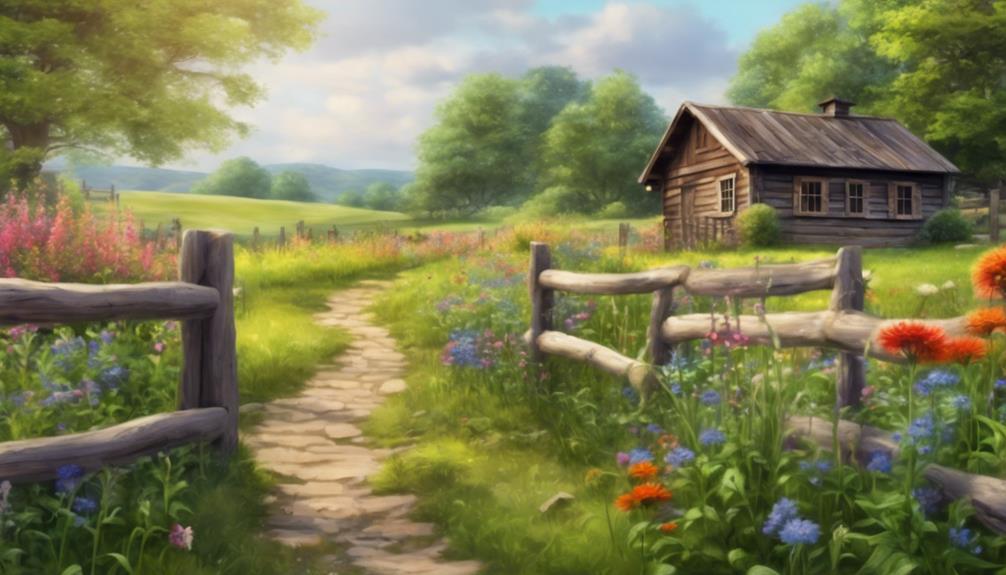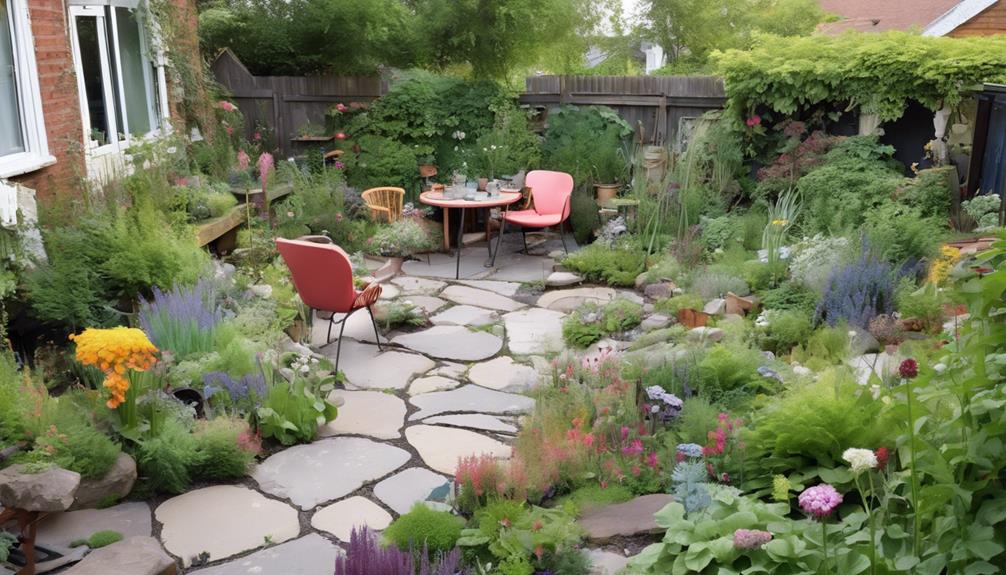
10 Tips for Rustic Garden Designs in Countryside Homes
18 September 2024
3 Best Garden Designs to Boost Curb Appeal
18 September 2024Choosing rustic garden designs for countryside homes provides a seamless blend with the natural environment, enhancing both aesthetic appeal and practicality.
These designs utilise natural materials such as wood and stone, fostering a timeless beauty that resonates with the surrounding landscape. They promote biodiversity by employing native plants that require less maintenance and support local wildlife.
Moreover, sustainable practices reduce the need for chemical interventions, ensuring a healthier ecosystem. Ultimately, rustic gardens create inviting spaces that encourage emotional connections to nature and outdoor adventure.
Continue to explore the diverse elements that make rustic gardens a perfect fit for countryside living.
Rustic Charm for Countryside Homes
Rustic charm is characterised by its timeless aesthetic appeal, which effortlessly blends with the natural surroundings of countryside homes.
The integration of natural materials, such as wood, stone, and native plants, enriches this charm, creating inviting and harmonious outdoor spaces.
Timeless Aesthetic Appeal
The picturesque allure of countryside homes is often defined by their seamless integration with nature, showcasing a timeless aesthetic that resonates with simplicity and warmth.
Rustic garden designs embody this ideal, infusing spaces with a sense of enduring beauty that transcends fleeting trends. The organic forms and natural palettes evoke a harmonious dialogue with the surrounding landscape, enhancing the home's character.
Elements such as meandering pathways, wildflower borders, and handcrafted structures create an inviting atmosphere that encourages exploration and connection. This aesthetic is not merely visual; it invites reflection and fosters an emotional bond with the environment.
Natural Materials Integration
Incorporating natural materials is essential for achieving the rustic charm that defines countryside homes. The use of wood, stone, and metal in garden designs creates an organic aesthetic that harmonises with the surrounding landscape.
Weathered timber, for example, imparts a sense of history, while handcrafted stone pathways evoke a connection to nature. Furthermore, wrought iron accents or reclaimed materials enhance the authenticity of the environment, fostering a cohesive look that resonates with simplicity and elegance.
Integrating native plants further complements these materials, reinforcing the relationship between the built and natural worlds.
Natural Materials Selection
The selection of natural materials is vital for creating authentic rustic garden designs that harmonise with the countryside landscape.
Utilising reclaimed wood for structures not only adds character but also promotes sustainability, while natural stone pathways enhance the organic aesthetic.
Furthermore, incorporating wildflower planting techniques fosters biodiversity and complements the overall rustic theme.
Reclaimed Wood for Structures
Utilising reclaimed wood for structures in rustic garden designs not only enhances the aesthetic appeal of countryside homes but also promotes sustainability. This eco-friendly approach offers numerous benefits that improve both the environment and the homeowner's experience.
- Unique Character: Each piece of reclaimed wood carries a history, providing a distinctive charm that new materials cannot replicate.
- Durability: Reclaimed wood, often sourced from older structures, is typically more resilient and can withstand decay better than new wood, ensuring longevity.
- Environmental Impact: By repurposing wood, homeowners reduce the demand for new timber, minimising deforestation and conserving natural resources.
Incorporating reclaimed wood into garden structures elevates the rustic aesthetic while fostering a conscientious relationship with nature, aligning beautifully with the ethos of countryside living.
Natural Stone Pathways
While designing a rustic garden, selecting natural stone pathways can greatly enhance the overall ambiance of a countryside home. The use of stone not only complements the landscape but also provides durability and a timeless aesthetic.
Here are three reasons to consider natural stone pathways:
- Visual Harmony: Natural stones blend seamlessly with the surrounding flora, enriching the garden's rustic charm.
- Sustainability: Using locally sourced stones minimises environmental impact and supports regional craftsmanship.
- Flexibility: Stones come in a range of shapes, sizes, and textures, allowing for creative designs that cater to individual tastes and garden layouts.
Incorporating natural stone pathways into your rustic garden will elevate its beauty and longevity, creating a welcoming atmosphere for family and friends.
Wildflower Planting Techniques
Creating a harmonious outdoor space often extends beyond pathways and into the vibrant world of wildflowers. Selecting natural materials for planting can greatly enhance the rustic charm of your garden.
Here are three crucial techniques for effective wildflower planting:
- Soil Preparation: Prioritise well-draining soil rich in organic matter. Conduct a soil test to determine pH levels and amend accordingly to suit wildflower species.
- Native Species Selection: Choose wildflowers native to your region. These plants are better adapted to local conditions and provide vital habitats for pollinators.
- Sowing Techniques: Employ a mix of broadcast seeding and row methods. This guarantees varied heights and blooming periods, creating a dynamic and visually appealing display.
Master these techniques to cultivate a thriving wildflower garden that complements your rustic landscape.
Create a Design Plan
Creating a design plan is essential to ensure your rustic garden aligns with your vision and practical needs.
Start by defining the purpose of your garden, as this will inform decisions on layout and plant selection.
Additionally, consider techniques for enhancing soil quality and implementing companion planting strategies to improve the overall health and productivity of your garden.
Define Your Garden's Purpose
Before delving into the intricacies of garden design, it is essential to clearly define the purpose of your garden. Understanding its primary function will guide your design choices and ensure the space serves your needs effectively.
Consider the following aspects:
- Entertainment: Will your garden host gatherings or serve as a tranquil retreat? Designing areas for seating and social interaction may be important.
- Cultivation: Are you aiming to grow vegetables, herbs, or flowers? A functional layout will optimise space and sunlight for different plants.
- Aesthetics: Do you seek to enhance the landscape's beauty? Incorporating visual elements such as pathways, borders, and focal points will elevate the overall appeal.
Defining these purposes will create a cohesive and fulfilling garden design.
Soil Quality Improvement Techniques
To enhance the health of your garden, implementing effective soil quality improvement techniques is essential.
A well-structured design plan can boost soil fertility, drainage, and microbial activity, fostering a flourishing rustic garden.
Here are three key techniques to consider:
- Organic Amendments: Incorporate compost, well-rotted manure, or green manure to enrich soil nutrients and improve structure.
- Mulching: Apply organic mulch to retain moisture, suppress weeds, and gradually enrich the soil as it decomposes.
- Soil Testing: Regularly test your soil's pH and nutrient levels to tailor amendments precisely, ensuring optimal conditions for plant growth.
Companion Planting Strategies
How can companion planting improve the overall health and productivity of your rustic garden? By strategically pairing plants, you can enhance nutrient absorption, deter pests, and promote biodiversity.
This method fosters a balanced ecosystem, resulting in healthier crops and increased yields.
To effectively implement companion planting, consider the following strategies:
- Mutual Benefits: Select plants that complement each other, such as tomatoes and basil, which enhance flavour and deter pests.
- Pest Control: Incorporate flowers like marigolds to attract beneficial insects that prey on harmful pests, thus reducing the need for chemical interventions.
- Soil Enhancement: Pair nitrogen-fixing legumes with heavy feeders like maize to improve soil fertility and support crop growth.
Enhanced Biodiversity in Gardens
Improved biodiversity in gardens plays a crucial role in fostering a balanced ecosystem, particularly in rustic countryside settings. By cultivating a variety of plant species, gardeners can attract beneficial insects, birds, and wildlife, enhancing the overall health of the environment. Diverse plantings create habitats and food sources that support a myriad of organisms, promoting ecological resilience.
| Biodiversity Benefit | Description |
|---|---|
| Pollination Support | Attracts bees and butterflies for improved fruit yields. |
| Pest Control | Natural predators help regulate pest populations. |
| Soil Health | Diverse root systems enhance soil structure and nutrient cycling. |
Incorporating these principles into rustic garden designs not only enriches the landscape but also nurtures the surrounding ecosystem, ultimately leading to a more sustainable gardening practice.
Sustainable Pest Management Techniques
Sustainable pest management is vital for maintaining the health and vigour of rustic gardens.
Techniques such as attracting beneficial insects, utilising organic mulching, and applying compost tea not only deter pests but also enhance soil quality and plant resilience.
Beneficial Insect Attracting Techniques
Creating a harmonious garden ecosystem requires a strategic approach to attracting beneficial insects that naturally manage pest populations. By implementing specific techniques, you can improve biodiversity and promote a self-sustaining environment in your rustic garden.
- Diverse Plant Selection: Incorporate a variety of flowering plants, including native species, to provide nectar and pollen for beneficial insects such as bees and butterflies throughout the growing season.
- Companion Planting: Utilise companion planting techniques to create symbiotic relationships, deterring harmful pests while inviting predatory insects like ladybirds and lacewings.
- Water Sources: Establish small water features or shallow dishes filled with pebbles to supply hydration for beneficial insects, ensuring they thrive and contribute to pest management.
Organic Mulching Benefits
Implementing organic mulching techniques can greatly enhance the health and productivity of rustic gardens while simultaneously promoting sustainable pest management.
Organic mulches, such as straw, wood chips, or grass clippings, create a barrier that suppresses weeds, retains soil moisture, and improves soil structure. Furthermore, they foster a habitat for beneficial organisms that assist in naturally controlling pest populations.
Here are three key benefits of organic mulching:
- Weed Suppression: Organic materials block sunlight, inhibiting weed germination and growth.
- Moisture Retention: Mulch reduces evaporation, maintaining ideal soil moisture levels for plants.
- Biodiversity Improvement: As they decompose, organic mulches enrich the soil, promoting a diverse ecosystem that supports pest deterrents.
Incorporating these practices ensures a thriving, sustainable garden.
Compost Tea for Nutrient Boost
Harnessing the power of compost tea can greatly enhance the nutrient profile of rustic gardens while serving as an effective tool for sustainable pest management.
This liquid gold, rich in beneficial microorganisms, not only nourishes plants but also fortifies them against pests and diseases.
To successfully implement compost tea in your garden, consider the following:
- Preparation: Steep well-aged compost in water for 24-48 hours, aerating periodically to promote aerobic bacteria.
- Application: Use a spray bottle or watering can to apply the tea directly to the soil and foliage, ideally during the early morning or late afternoon to optimise absorption.
- Frequency: Apply compost tea bi-weekly during the growing seasons to ensure maximum nutrient uptake and pest resistance.
Embrace this practice for a thriving, sustainable garden.
Pest Control Without Chemicals
Incorporating pest control measures without chemicals is crucial for maintaining a healthy rustic garden.
Utilising native plant selection can improve biodiversity, while specific natural pest deterrent plants can effectively ward off unwanted insects.
Furthermore, implementing effective crop rotation methods contributes to a sustainable approach, reducing pest populations and promoting soil health.
Native Plant Selection
While many homeowners strive to maintain a pest-free garden, selecting native plants can offer an effective, chemical-free approach to pest control.
Native plants are inherently adapted to the local ecosystem, promoting biodiversity and attracting beneficial insects that naturally manage pest populations. By integrating native flora into your rustic garden design, you create a harmonious environment that minimises the need for chemical interventions.
Consider the following benefits of native plant selection:
- Enhanced Biodiversity: Native plants support local wildlife, including pollinators and predatory insects.
- Reduced Maintenance: These plants require less water and fewer resources, making them easier to care for.
- Natural Resilience: Native plants possess innate defences against local pests, reducing infestations organically.
Embrace native selections for a healthier garden ecosystem.
Natural Pest Deterrent Plants
Integrating native plants not only enhances biodiversity but also establishes a foundation for incorporating natural pest deterrent plants into your rustic garden design.
Utilising such plants can significantly diminish the need for chemical pesticides, promoting a healthier ecosystem.
Here are three effective natural pest deterrent plants:
- Marigolds: Their vibrant blooms emit compounds that repel nematodes and various insects.
- Lavender: The strong fragrance deters moths, fleas, and even mosquitoes while attracting beneficial pollinators.
- Basil: This culinary herb not only enhances your meals but also repels flies and mosquitoes, serving as a dual-purpose addition.
Effective Crop Rotation Methods
Crop rotation is a fundamental agricultural practice that enhances soil health and minimises pest issues without the reliance on chemical interventions.
By systematically changing the types of crops grown in a specific area, gardeners can disrupt pest life cycles and boost nutrient availability in the soil.
Consider these effective crop rotation methods:
- Legume Integration: Incorporate legumes to fix nitrogen in the soil, thereby enhancing fertility for subsequent crops.
- Family Rotation: Rotate crops by family (e.g., brassicas, nightshades) to prevent the build-up of pests and diseases specific to plant families.
- Cover Cropping: Utilise cover crops during off-seasons to prevent erosion, suppress weeds, and improve soil structure.
Employing these strategies will cultivate a sustainable, productive garden while reducing the need for chemical pest control.
Why Choose TKL Birmingham Gardener
Choosing TKL Birmingham Gardener for your rustic garden design guarantees a blend of expertise and a deep understanding of countryside aesthetics.
With a commitment to creating sustainable and visually appealing landscapes, TKL Birmingham Gardener employs innovative techniques tailored to the unique characteristics of rural settings.
Their team is skilled in selecting native plants that thrive in the local environment, ensuring a harmonious integration with the surrounding landscape.
Moreover, their meticulous attention to detail in hard landscaping elements enhances the rustic charm, making every garden a true reflection of its owner's vision.
TKL Birmingham Gardener's collaborative approach fosters communication, allowing clients to be actively involved in the design process, resulting in personalised spaces that resonate with authenticity and elegance.
Common Questions and Insights
When embarking on a rustic garden design, several common questions arise that can assist homeowners in achieving their desired aesthetic.
One vital consideration is the selection of materials; reclaimed wood, natural stone, and wrought iron often evoke the rustic charm sought after.
Moreover, homeowners frequently inquire about plant selection; native species and perennials can enhance the garden's organic appeal while fostering local biodiversity.
The arrangement of plantings is also important; asymmetrical layouts and layered heights contribute to a more naturalistic appearance.
In addition, the integration of functional elements, such as seating areas and pathways, should harmonise with the overall design.
Understanding these foundational aspects can greatly aid in creating a cohesive and inviting rustic garden that reflects personal style while respecting the countryside setting.
Garden Maintenance Tips Ahead
Maintaining a rustic garden requires a thoughtful approach to ensure its enduring beauty and functionality.
A well-maintained rustic garden blends seamlessly with the countryside while showcasing the unique charm of natural materials and wildlife.
Here are three crucial maintenance tips:
- Regular Pruning: Regularly prune shrubs and trees to promote healthy growth and maintain the desired shape, ensuring a balanced aesthetic.
- Soil Health: Test your soil annually and amend it with organic matter, such as compost, to improve fertility and support plant health.
- Weed Control: Implement a mulch layer to suppress weeds and retain moisture, reducing the need for chemical herbicides and promoting a more sustainable environment.




